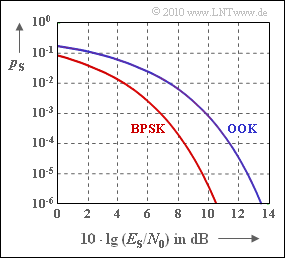Exercise 4.11Z: OOK and BPSK once again
The error probabilities pS of the digital modulation methods "On–Off Keying" (OOK) and "Binary Phase Shift Keying" (BPSK) are given here without derivation.
For example, one obtains with the so-called Q-function
- Q(x)=1√2π⋅∫+∞xe−u2/2du
for the AWGN channel – identified by ES/N0 – and other optimal conditions (e.g. coherent demodulation)
- for On–Off Keying, often also called "Amplitude Shift Keying" \rm (2–ASK):
- p_{\rm S} = {\rm Q}\left ( \sqrt{{E_{\rm S}}/{N_0 }} \hspace{0.1cm}\right ) \hspace{0.05cm},
- for Binary Phase Shift Keying:
- p_{\rm S} = {\rm Q}\left ( \sqrt{{2 \cdot E_{\rm S}}/{N_0 }} \hspace{0.1cm}\right ) \hspace{0.05cm}.
These symbol error probabilities (at the same time the bit error probabilities) are shown in the graph.
For example, for 10 \cdot {\rm lg} \, E_{\rm S}/N_0 = 10 \ \rm dB one obtains according to the exact functions:
- p_{\rm S} = 7.83 \cdot 10^{-4}\,\,{\rm (OOK)}\hspace{0.05cm},
- p_{\rm S} = 3.87 \cdot 10^{-6}\,\,{\rm (BPSK)}\hspace{0.05cm}.
In order to achieve p_{\rm S} = 10^{\rm -5} with BPSK, 10 \cdot {\rm lg} \, E_{\rm S}/N_0 ≥ 9.6 \ \rm dB must hold.
Notes:
- The exercise belongs to the chapter "Carrier Frequency Systems with Coherent Demodulation".
- You can also find the derivations in the chapter "Linear Digital Modulation – Coherent Demodulation".
- For the complementary Gaussian error function, use the following approximation (upper bound):
- {\rm Q}(x) \approx \frac{1}{\sqrt{2\pi} \cdot x} \cdot {\rm e}^{-x^2/2} \hspace{0.05cm}.
Questions
Solution
- p_{\rm S} = {\rm Q}\left ( \sqrt{10} \right ) \approx \frac{\rm 1}{\sqrt{\rm 20\pi} }\cdot \rm e^{-5 } \underline{=85 \cdot 10^{-5}}\hspace{0.05cm}.
- The actual value according to the data section is 78.3 \cdot 10^{\rm -5}.
- So the given equation is actually an upper bound for {\rm Q}(x).
- The relative error when using this approximation instead of the exact function {\rm Q}(x) is in this case less than 10\%.
(2) For BPSK, the corresponding equation is:
- p_{\rm S} = {\rm Q}\left ( \sqrt{20} \right ) \approx \frac{\rm 1}{\sqrt{\rm 40\pi} }\cdot \rm e^{-10 } \underline{=0.405 \cdot 10^{-5}}\hspace{0.05cm}.
- Now the relative error using the approximation is only 5\%.
- In general: The smaller the error probability, the better the approximation.
(3) According to the specification, a (logarithmic) value of 9.6 \ \rm dB is required for BPSK.
- With the OOK, the logarithmic value must be increased by about 3 \ \rm dB ⇒ 10 \cdot {\rm lg} \, E_{\rm S}/N_0 \ \underline {\approx 12.6 \ \rm dB}.
